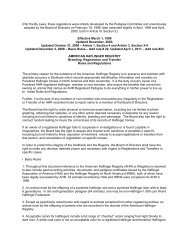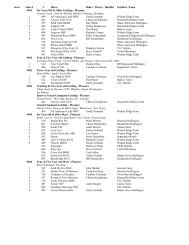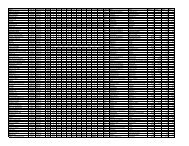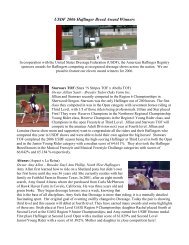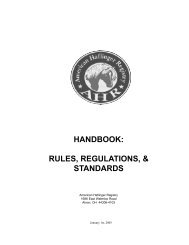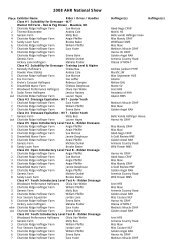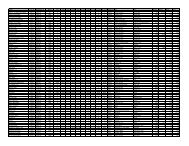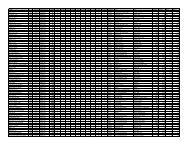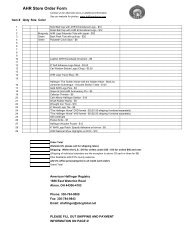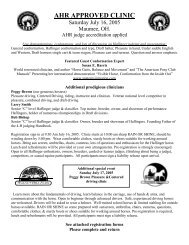handbook - American Haflinger Registry
handbook - American Haflinger Registry
handbook - American Haflinger Registry
Create successful ePaper yourself
Turn your PDF publications into a flip-book with our unique Google optimized e-Paper software.
5. Conformation: The quality and correctness of type, head, neck, forehand, midsection, hindquarters,front legs and hind legs. Predisposition to unsoundness, limitation in quality of movement caused byweakness or conformation faults, potential for trainability and performance. Emphasis on function, notfashion. Blemishes are not to count unless resulting from conformation faults. Good harmoniousconformation suitable for dressage performance.D. EXERCISE AREASThe following restrictions begin with the first day of dressage and continue throughout the duration. Thefollowing are compulsory: an English type saddle and any form of bridle, including double bridle, snaffle orhackamores. Running martingales, Irish martingales, bit guards, boots, bandages, fly shields, nose covers, andseat covers are permitted. Side reins are permitted only while lunging an unmounted horse. Other martingales,any form of gadget (such as bearing, running or balancing reins, etc.) and any form of blinkers are forbidden,under penalty of disqualification.E. DRESSAGE TEST1. Tack: The following are compulsory: an English type saddle and a permitted bridle. A double bridlewith cavesson noseband, i.e. bit and bridoon with curb chain is permitted for some tests. A lipstrap andrubber or leather cover for the curb chain are optional. The lever arm for the curb bit must not exceed 8cm (3 1/8 inches) in length. A snaffle made of metal, leather, rubber, or plastic material is permitted forall tests. The bridle may have a cavesson noseband, dropped noseband, crossed noseband or flashnoseband. The noseband must be made entirely of leather or leather like material, except for a smalldisc of sheepskin, which may be used in the intersection of the two leather straps of a crossed noseband.A breast plate may be used. For drawings of permitted bits and nosebands, see Appendix A. Anordinary snaffle is a plain snaffle with a straight bar or joint in the center. If a snaffle has two joints, allparts must be rounded and smooth.2. INSPECTION OF EQUIPMENTA steward should be appointed to check the saddlery of each horse before it enters the arena orstarts a test.In the Dressage Test, the checking of the bridle must be done with the greatest caution. If the competitorso requests, the bridle and bit may be checked immediately after the test has been completed. However, shouldthe bridle or bit in such a case be found not to be permitted, the competitor shall be eliminated.3. JUDGINGIn all dressage classes, any circumstances not specifically covered by these rules, the USEFRulebook, Dressage Division shall serve as the reference for all other rules and requirements not covered in theAHR Handbook.A competitor failing to enter the arena within 60 seconds of the starting signal will be eliminated, at thediscretion of the Ground Jury. The same applies to a competitor who enters the arena before the starting signalhas been given.A test begins with the entry at A and ends after the salute at the end of the test, as soon as thehorse moves forward. Any incidents before the beginning, or after the end of the test have no effect on the marks.Competitors must take the reins in one hand at the salute. Gentlemen are not required to remove theirhats at the salute.When a movement must be carried out at a certain point of the arena, it should be done when thecompetitor’s body is above the point.The use of the voice in any way whatsoever or clicking of the tongue once or repeatedly is a serious faultinvolving the deduction of at least two marks from those that would otherwise have been awarded for themovement where this occurred.7/08 VI-A-1773




